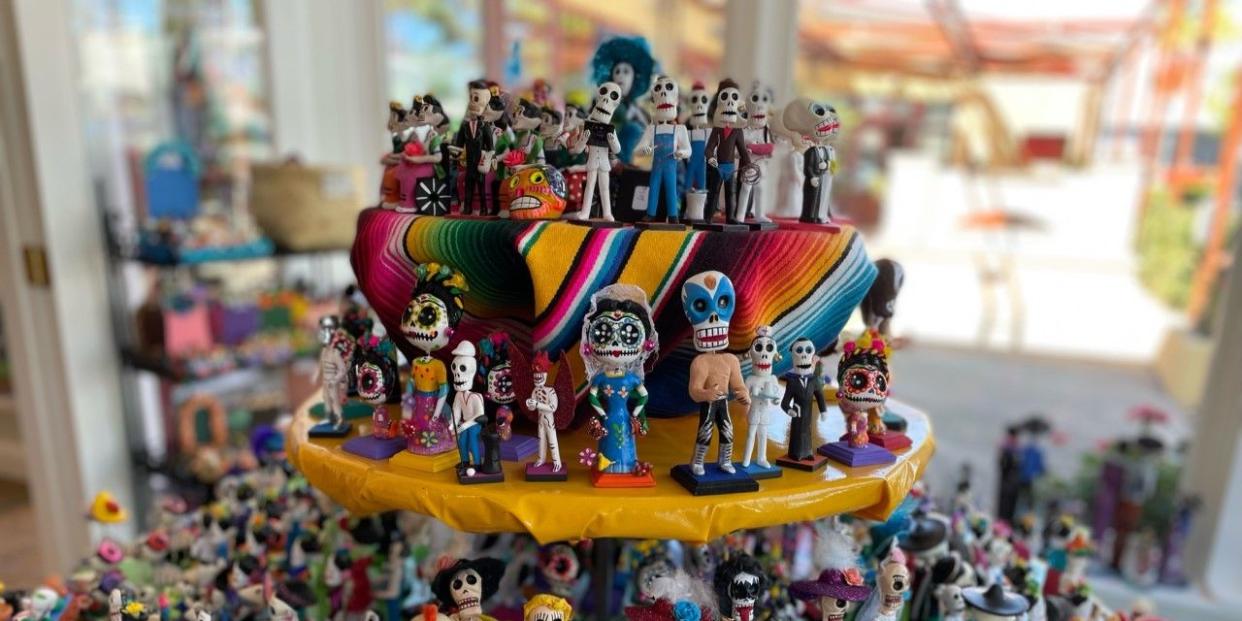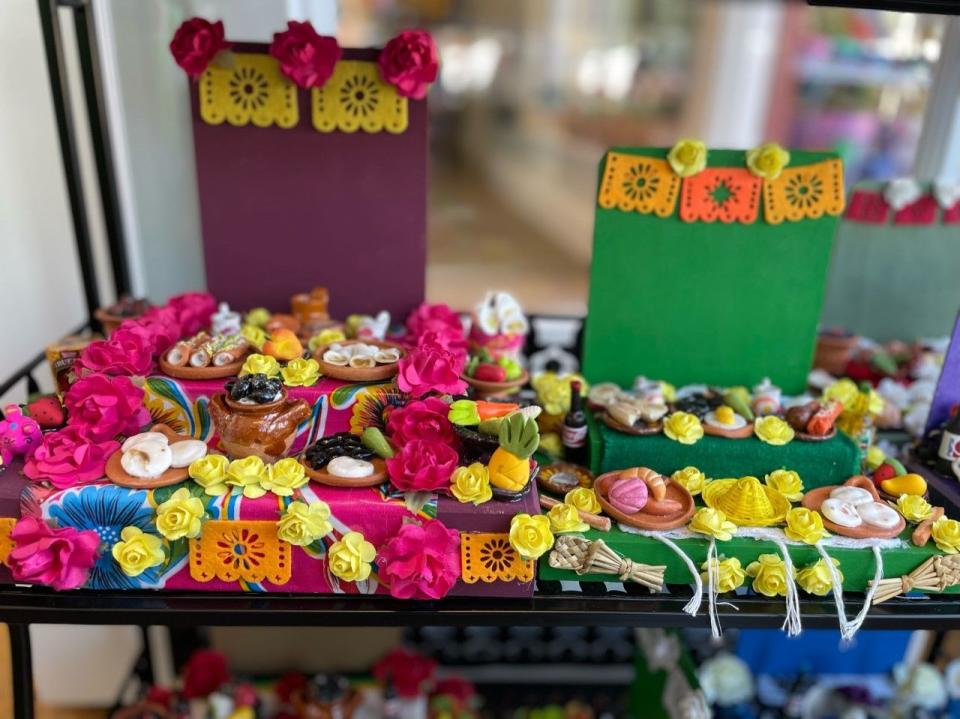The Power of Ofrendas on Día de los Muertos

When you Google the city of Healdsburg, California, the most significant results are links to the town’s tasting rooms and coveted restaurants. However, a few steps further from the Healdsburg Plaza is Alma’s Oilcloth and Chucherias, owned by Alma Vigil, who has been making small altars for 10 years.
The store features all kinds of Mexican cultural products, but the most coveted items are the Día de los Muertos altars and ofrendas Vigil makes by hand—pieces so special, they have put her business on the map and given her success for years. On her Instagram, a little over 50,000 people follow her. Vigil’s work is painstakingly precise. Usually, altars—or ofrendas—are made with boxes or tables to create three tiers. A picture of the deceased is placed in one tier, and food and decorations are placed in the other levels. Marigold flowers known as cempasúchil are used as decoration, and it is believed they guide loved ones to the altar. The tradition is rooted in Aztec beliefs about honoring the dead; later on, the practice became intertwined with Catholic traditions. It is celebrated on November 1 (All Saints’ Day, which celebrates children who have died) and November 2 (All Souls’ Day, which celebrates adults).
These altars are extremely important to Mexican culture because the idea is that, for those two days, people who have been lost come back down to Earth to be around their loved ones. It is a tradition based on nostalgia and a love and connection with them. The altars are usually made by hand and seen in cemeteries, churches, schools, and private homes.

The practice of altars and ofrendas is a deep part of Mexican spirituality. Even though Mexican culture has a Catholic majority, the syncretic spiritualities among its people is extensive. There are those who believe healing can come from plants, the gods, et cetera. This holiday in particular connects those two sides. For some, including the religiously devout, wanting to bring back the dead for a day or two might sound appalling and against some religious norms. But many devout Mexican Catholics who are usually against these practices observe this day because the essence of it is to honor and celebrate—hence the lively colors, the papel picado (“punched” paper banners made out of paper or plastic panels that are cut with intricate designs), and the flowers.
Vigil was inspired by the Michoacán altars she used to see when she visited Mexico with her parents. “We would go for a day, and we’d clean out the cemetery where my grandparents are buried and sweep it off, put fresh flowers,” she says.

Vigil wanted to do something similar but different. It is unusual to see or be able to purchase altars that are premade like Vigil’s. Most of the time, people build their own, a practice that can take a day or more.
“I had seen a couple similar, but not the same in Mexico. But nothing like I make here,” she says. Hers are made to order. Clients just have to place the photos at the top or add a few more elements to them. Vigil re-creates a smaller version of the traditional altars, ready for people to celebrate.
When Vigil first started making her Día de los Muertos altars, she made 30 a month before the season began. Now, she makes up to 20 a week. For Vigil, every altar brings new inspiration. Not one is the same.
“They do take a while to make, just because I am very picky about the details. Some people like pan dulce (sweet bread), since I do the miniature foods, but I try to make a variety and do color combinations and just try to make them different but similar,” Vigil says.
On a regular work day, she can make eight altars. Vigil begins to paint and assemble in July.
“If I started to do it from scratch, it would probably take two to three hours, just to assemble and paint,” she says. The altars require three layers of paint, and the miniature food and flowers must be glued on.
Her most-sold items always change. Last year, it was her larger altars, and this year it’s her smaller ones.
When it comes to who buys her altars more, Vigil said there is a 50/50 ratio of tourists to locals. “Yesterday, I had someone come from Florida. I had another couple from Sacramento,” she says about her physical store. Online, it is mostly Latinx shoppers. Demand has been so high that Vigil moved into a new and bigger space. It has a special room dedicated to holidays and special occasions. In the future, she would like to hold workshops.
“When Coco started, I just saw a lot of people who were not Latinos start to think, ‘Wow, your culture really doesn’t think of it as a sad thing.’ To make it lively and happy, to remember those that we have lost, is just beautiful,” she says.
Vigil grew up in a nearby city called Sebastopol but reminisces on the past culture of the area where Healdsburg is.
“Back in the day, in the ’60s and ’70s, it was very big on agriculture. And there are a lot of Latinos, because that’s where a lot of people came to work and make the agriculture and the wine country thrive with their hard work. I’m glad to be able to represent a little bit of our culture here,” she says.
Vigil’s store is not in the forefront of the Healdsburg Plaza, but she encourages tourists to explore what might not be the typical tourist stop.
“I think a lot of tourists just focus on the plaza area, and they don’t even know there’s a whole other world once you pass the three or four main blocks of Healdsburg,” she says.
Healdsburg is known for being one of the most expensive areas to buy a house or rent an apartment. But its economy relies heavily on tourists who visit to go wine tasting. Having a business owner such as Vigil is a satisfying reminder that Latinx labor can be both successful and highlighted. Many tourists do not realize the people washing the dishes in the five-Michelin-star restaurants they visit or the grape growers are the backbone of the indulgences they get to enjoy. Vigil has had Latinx customers ask her if she speaks Spanish because they are not used to seeing someone like her in the area or someone who they do not have to make accommodations for. She is representative of what true diversity could one day be.
Celebrating and commemorating Día de los Muertos is important to Vigil because she considers it to be a beautiful tradition for Mexican culture. This year in particular has been tough for her to work, as she lost her father two months ago.
“Parents, grandparents, children, a lot of people lose their babies, so it’s a nice time to sit around to light a candle for them and remember the good things and to keep them alive in our heart, in our lives,” she says. “I want locals and tourists to learn how to make their own ofrendas or their own paper flowers or some of the pieces that I make. I just want them to also participate and get to experience it.”
You Might Also Like

